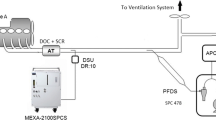Abstract
In spite of the importance of the mixture preparation process during starting in affecting HC emissions, it has been poorly understood because the process is highly complicated by the multi component fuel, transient thermal environment, and two-phase mass transfer. For better understanding of the process, measurement of the equivalence ratio in the cylinder was attempted using a fast FID (Flame lonization Detector). Although extensive research has been made on the measurement using the fast FID, the method is not yet straightforward and needs careful operation. In this paper, the current status of the method is described. And within the limitations of the method the in-cylinder sampling test was conducted under the engine operating condition of 900 rpm, 0,527 bar intake pressure with gasoline injceted. The test results show that 15 to 20% of the injected fuel evaporates in the first cycle regardless of the amount of fuel injected. The lean limit of the equivalence ratio for engine firing was about 0.6. For secure firing in the first cycle, 5 to 6 times the stoichiometric fuel amount had to be injected. The contribution of the left-over fuel in the previous cycles to the mixture formation in the present cycle was found to be substantial.
Similar content being viewed by others
References
Brown, C. N. and Ladommatos, L., 1991, “The Effects of Mixture Preparation and Trapped Residuals on the Performance of a Spark-ignition Engine with Air-shrouded Port Injectors, at low Load and Low Speed”,Proc. Instn Mech. Engrs. Vol. 205, pp. 17–29.
Cambustion Ltd., 1992, “User Manual and Specifications: HFR 400 Fast FID.”
Cheng, W. K., Galliot, F. and Collings N., 1989, “On the Time Delay in Continuous In-Cylinder Sampling From IC Engines,”SAE paper 890579.
Collings N., 1988, “A New Technique for Measuring HC Concentration in Real Time, in a Running Engine,”SAE 880517.
Galliot, F., Cheng W. K., Cheng C. O., Sztenderowicz, M. and Heywood J. B., 1990, “In-Cylinder Measurements of Residual Gas Concentration in a Spark Ignition Engine,”SAE paper 900485.
Lawson, J. and Weinberg, F. J., 1969,Electrical Aspects of Combustion, Clarendon Press.
Patterson, D. J., 1972,Emissions from Combustion Engines and Their Control, Ann Arbor Science.
Rose D., Ladommatos N. and Stone R., 1994, “In-Cylinder Mixture Excursions in a Port-Injected Engine During Fast Throttle Opening,”SAE paper 940382.
Saito, K., Sekiguchi, K., Imatake, N., Takeda, K., and Yaegashi, T., 1995, “A New Method to Analyze Fuel Behavior in a Spark Ignition Engine,”SAE paper 950044.
Shin, Y. G., Min, K. D. and Cheng, W. K., 1995, “Visualization of Mixture Preparation in a Port Fuel Injection Engine During Engine Warmup,”SAE paper 952481.
Sternberg, J. C., Gallaway, W. S., and Jones, D. T., 1962.The Mechanism of Response of Flame lonization Detectors, N., Callen, and Weiss, M. D. (Ed.), Gas Chromatography, Academic Press, New York, N. Y., pp. 231–267.
Summers, T., 1996, Private communication, Cambustion LTD.
Summers T. and Collings N., 1995, “Modelling the Transit Time of a Fast Response Flame Ionisation Detector During In-Cylinder Sampling,”SAE 950160.
Author information
Authors and Affiliations
Rights and permissions
About this article
Cite this article
Shin, Y. Measurement of in-cylinder equivalence ratio during starting using a fast FID. KSME International Journal 11, 726–736 (1997). https://doi.org/10.1007/BF02946343
Received:
Issue Date:
DOI: https://doi.org/10.1007/BF02946343




